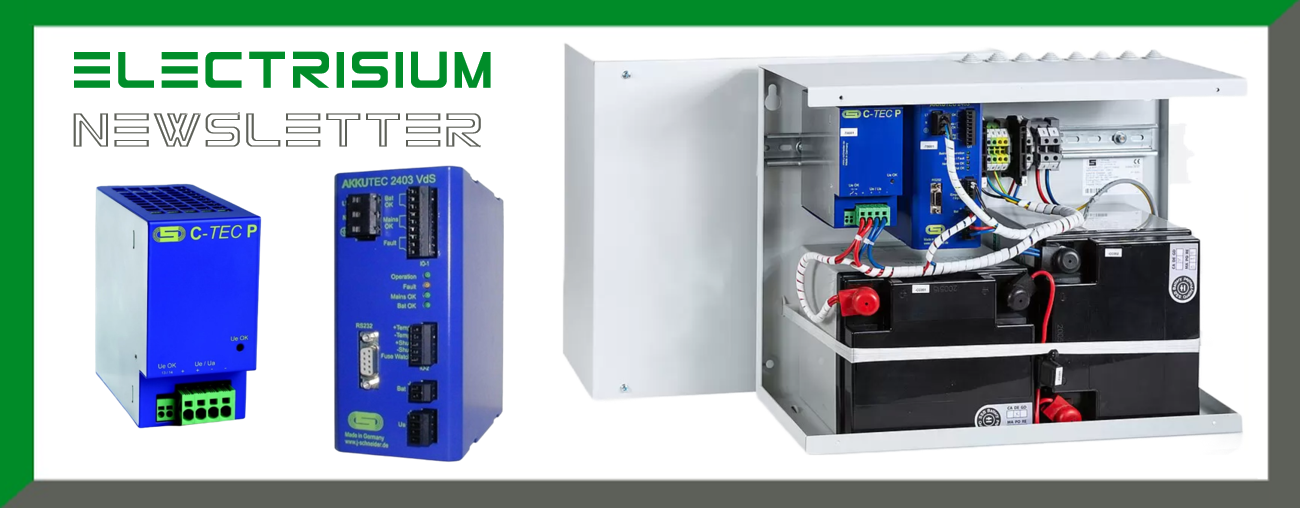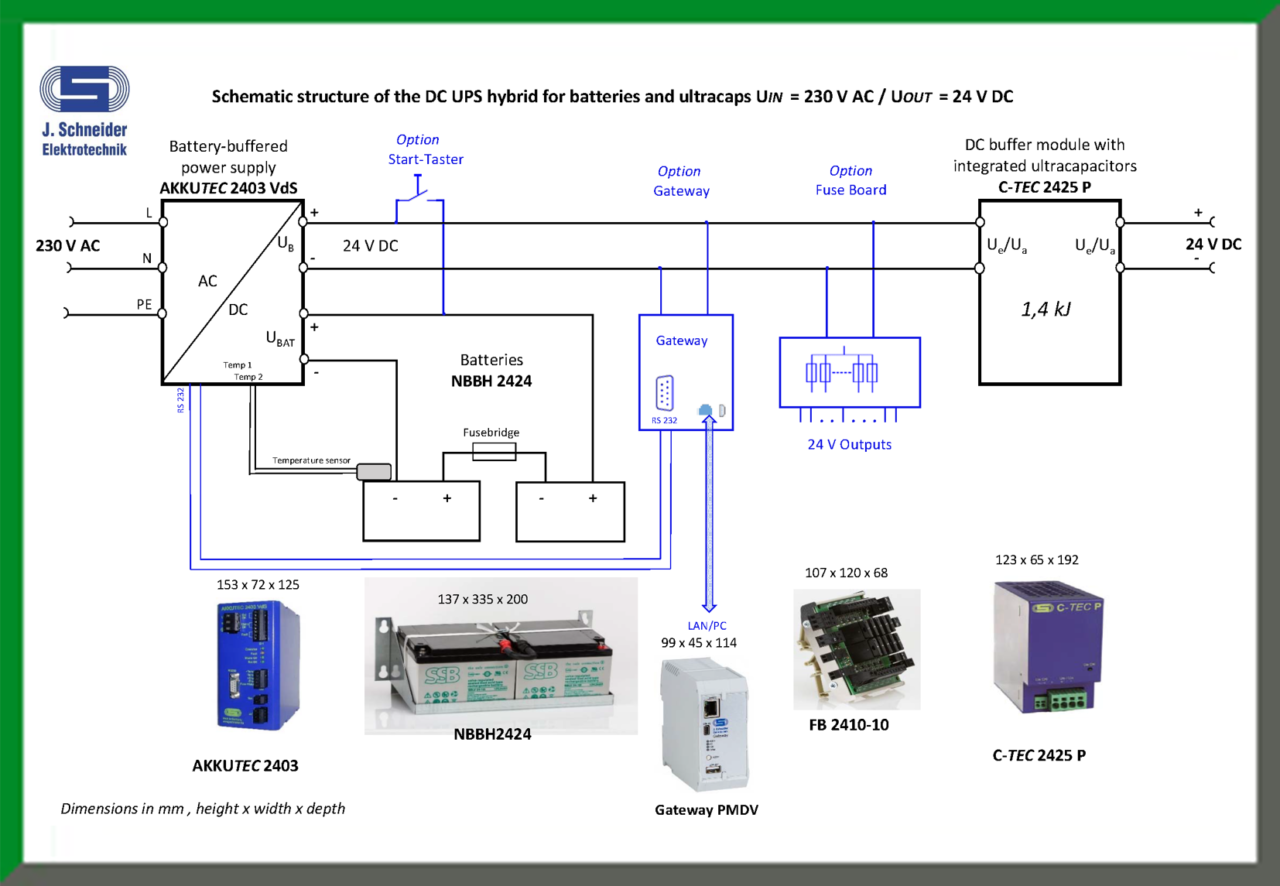Dear friend of Electrisium,
in this article we will present a solution for a hybrid UPS and will describe its functions. Many of today’s applications require an uninterruptible power supply (UPS) for back-up time, safety or for many other reasons.
Why is a high current loadable long-term buffering really necessary?
Consumer with critical infrastructure like fire alarm systems, gas warning systems, alarm and signaling lighting systems, smoke and heat extraction systems, network transfer stations and many other critical infrastructures should use a direct current UPS system with a long term and secure power supply.
With such long-term buffering, it often occurs in practice that after a long discharge time of the battery with a very low load, a short-term high current is required at the end. An already strongly aged or discharged battery could not deliver such a current and breaks down. A new „Hybrid UPS” can remedy such a situation and will also deliver the required high current.
Schneider Elektrotechnik GmbH is the company with the right specialization when it comes to providing the appropriate UPS systems in cabinets or wall-mounted enclosures. No matter the buffering time, whether only a few minutes or several hours are needed, J. Schneider Elektrotechnik GmbH always provides the perfect UPS solution considering the required size and the battery capacity.
Schneider Elektrotechnik GmbH has developed the Hybrid UPS especially for applications according to the German Technical Connection Rules for Medium-Voltage (VDE-AR-N 4110) which state that “if the auxiliary power is supplied by a battery system, it must be dimensioned in such a way that all protection, secondary and auxiliary equipment for the operation of the transfer station including the counting and measuring devices can continue to be operated for at least 8 hours in the event of a mains voltage failure. Three complete switching sequences must be possible within this time.”
For long-term buffering, the lead battery is generally the choice as energy source, as long as it is pure backup processes and the load on the battery is constant during the entire buffer period and not a cyclical application. However, it becomes problematic, when higher currents are required at least temporarily, for example in case of switching operations, starting currents of motors etc., that have a major impact on the batteries. In particular, the increase of their internal resistance (RI) by aging or by discharge is an important factor that influence their performance.
► Increasing in the RI through aging: The longer the service life increases, the greater the internal resistance of the battery, and moreover, at high temperatures, this process accelerates.
► Increase of the RI by discharging: The deeper the battery is discharged during buffering, the more the internal resistance is increased.
How can a reliable performance be ensured over a long period of time?
There is of course the option of over dimensioning the calculated battery capacity, but the exact oversizing factor is difficult to predict, thus even so it is no certainty that the system is properly dimensioned. It would be conceivable to use a battery having a bigger capacity, but that doesn’t control the problem of the increase in the internal resistance due to „normal” aging, and in addition, the acquisition costs and the space requirements are also increasing. Alternatively, it is also possible to carry out regular maintenance and tests. However, the more capacity on a system, the more are increasing the time duration of maintenance and personnel costs.
To directly deal with this issue described above, J. Schneider Elektrotechnik GmbH has developed a special hybrid UPS which ensures a very long use of the batteries and maximum reliability (without extreme high personnel costs for examination).
By combining the advantages of a battery charger of the AKKUTEC series with battery monitoring (RI measurement and battery circuit test) and a direct current UPS of the C-TEC series with ultracapacitors, the long-term buffering required by VDE-AR-N 4110 is realized and, at the same time, several safe switching operations with inrush current peaks up to 25 A are possible during or at the end of the 8-hour buffer time of the base load. If the AKKUTEC reports an extreme increase in the RI, the batteries must be replaced.
The devices of the AKKUTEC series use batteries as energy storage and operate in standby parallel mode. During mains operation, it supplies the load and the battery simultaneously, so the battery is kept fully charged. If the main power source is interrupted, the battery buffers until it has reached its deep discharge limit. The battery management integrated in the AKKUTEC devices protects the battery and makes the system safe and highly available.
The devices of the C-TEC series include ultracapacitors inside their housing as energy storage. If the DC supply is interrupted, the energy of the ultracapacitor is released in a controlled manner. The load is supplied by the ultracapacitor until it is discharged. The buffer time depends on the state of charge of the capacitor and on the discharge current.
The two devices have been specially designed to work together for ensuring an optimal supply. Their combination shows its strengths in applications with the following critical situations:
► the system is already close to the end of the discharge;
► the batteries have already aged and the RI value has increased accordingly;
► temperatures below 10°C prevail in the application area;
► a combination of several of the above.
Several components can be added as options to the hybrid UPS:
► The Gateway connects by a network a UPS or a master-slave system to a PC. With the help of an installed software, such as TECBusManager, TECControl or paraTEC VdS, monitoring and parameterization tasks on the UPS systems can be carried out.
► The Fuse Boards can be snapped onto C-rails and are available in two versions, with 5 or 10 fuses, each fuse being monitored separately. In case of fuse failure, the corresponding LED goes out. A message signals a blown fuse to the AKKUTEC.

What happens after the 8 hours of buffer time?
► The system buffers until the batteries reach their deep discharge limit and then switches off the load (this should not be less than 1.8 V / cell for long-term discharges with a low load), otherwise the batteries are destroyed.
► Alternatively, after the required time of 8 hours, an automatic switch-off can be carried out via the AKKUTEC device. In this case, residual energy remains in the batteries. The hybrid UPS can be activated manually by means of a button; the residual energy of the batteries is sufficient to recharge the ultracapacitor module within a few seconds after which switching via the UPS is possible again.
Thanks to the various possible combinations of AKKUTEC and C-TEC P units with batteries of different capacities, the hybrid UPS can be designed specifically for almost any application. The systems are available in various enclosures such as IP 31 or IP 54.
If you have questions or if you need more information, we would gladly help you, so contact us.
All the best,
The ELECTRISIUM team


